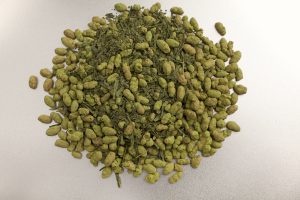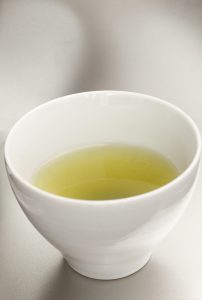 This tea was given to me by Kyle Whittington, along with other Japanese teas that I’ll be reviewing in the future.
This tea was given to me by Kyle Whittington, along with other Japanese teas that I’ll be reviewing in the future.
It’s no secret that I love genmaicha, so I was quite happy to try this tea from Tea Studio. In case that you haven’t listened to my last podcast (episode 11) Whittington’s Tea Emporium sells teas from different brands.
This tea is from the Kakegawa region of the Shizuoka prefecture. It consists of matcha, sencha leaves and roasted rice. As opposed to normal genmaicha, it has a uniform green color, and let’s be honest, who doesn’t love matcha?
Let the tasting begin
First I opened the package to smell the tea. You can smell the matcha component and overall it’s a refreshing, vegetal aroma.
The brewing instructions are 70 °C (158 °F) and 1 to 2 minutes brewing time. I decided to look at Japanese pages online to see what other guidelines there where, and they vary a lot.
Some companies brew it like a normal genmaicha, with boiling water and a short brewing time (30 seconds). So that I can compare it with the other genmaicha that I’ve reviewed, I’ll prepare it that way. I used a teaspoon of tea and 120 ml (4 oz) of water.
 For the first infusion, there’s a cloudy green color. It’s darker than a genmaicha but not as much as matcha.
For the first infusion, there’s a cloudy green color. It’s darker than a genmaicha but not as much as matcha.
It smells just like genmaicha, a nutty aroma due to the roasted rice.
The taste is sweet and a bit nutty. I thought that the matcha would add a little bitterness but it’s not the case. There’s also no noticeable astringency.
I then tried a second infusion, with the same temperature and a bit more time. The result is pretty much the same aroma, but a lighter color and taste.
This is a good everyday tea, and as a bonus, the matcha makes it more nutritious. If you like matcha and genmaicha, you won’t be disappointed.


November 6, 2013
Nice article. It is interesting that they suggest such a low brewing temperature. I’ve brewed genmaicha in various ways over the years, and to my taste anyway, going with hotter temps seems to be the way to go
November 6, 2013
Hi Griff
I like genmaicha with hotter water too, but I’m guessing that perhaps since this tea has sencha instead of bancha, they recommend a lower temperature.